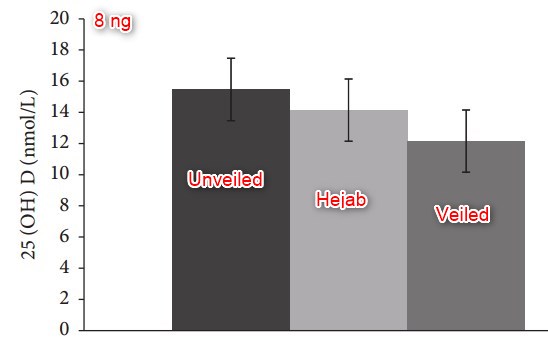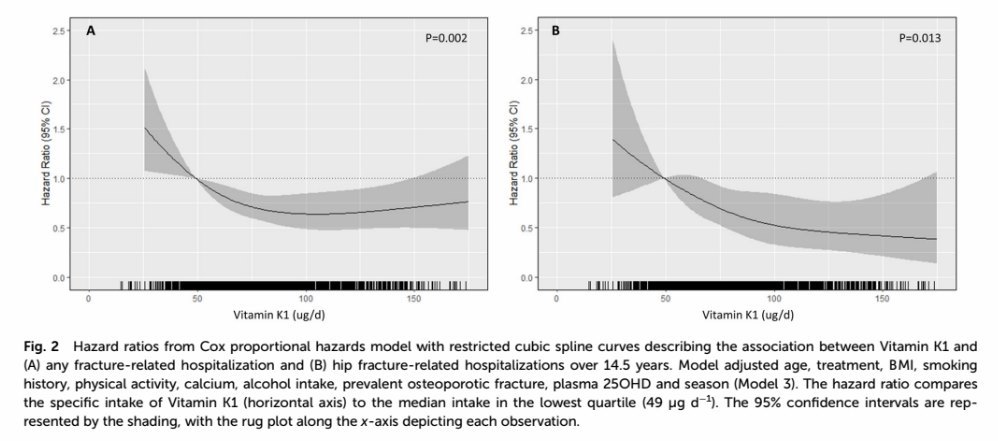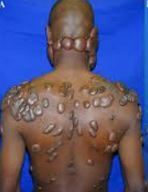Need 1 hour of noon sun to get Hijab women to 20 ng of Vitamin D (cloth)
Several studies on this page
Optimizing ultraviolet B radiation exposure to prevent vitamin D deficiency among pregnant women in the tropical zone: report from cohort study on vitamin D status and its impact during pregnancy in Indonesia.
BMC Pregnancy Childbirth. 2019 Jun 21;19(1):209. doi: 10.1186/s12884-019-2306-7.
Judistiani RTD1,2, Nirmala SA3,4, Rahmawati M5, Ghrahani R4,6,7, Natalia YA3, Sugianli AK7,8, Indrati AR4,7,8, Suwarsa O4,7,9, Setiabudiawan B4,6,7.
 * Pregnant Arab women 25 X more likely to have low vitamin D if indoors a lot – April 2018
* Malay women 14 X more likely to be Vitamin D deficient than Chinese in Malay – July 2017
* They wear more concealng clothing
---
Note: It appears that NONE of the women were actually in the sun for 1 hour a day.
The 1 hour was an extrapulation from their data
* Pregnant Arab women 25 X more likely to have low vitamin D if indoors a lot – April 2018
* Malay women 14 X more likely to be Vitamin D deficient than Chinese in Malay – July 2017
* They wear more concealng clothing
---
Note: It appears that NONE of the women were actually in the sun for 1 hour a day.
The 1 hour was an extrapulation from their data
📄 Download the PDF from VitaminDWiki
BACKGROUND:
Vitamin D deficiency during pregnancy carries potential threat to fetal well being. Natural conversion of vitamin D in the skin can be facilitated by direct ultra violet B (UVB) radiation, but the effect is reduced by wearing umbrellas, clothes, or sunblock cream. Muslim women wear hijab that allows only face and hands to be seen. With increasing proportion of muslim women wearing hijab and the lack of vitamin D fortification and fish consumption in Indonesia, it poses a problem for vitamin D deficiency among pregnant women. This study aimed at finding the best timing of UVB exposure and the duration of exposure which can be suggested to prevent vitamin D deficiency among pregnant women, for those wearing hijab or not.
METHODS:
This study recruited 304 pregnant women in the first trimester, 75-76 women from 4 cities of the most populated province, West Java, Indonesia which represented 70-80% percent of pregnancy per year. A 3-day notes on duration, time and type of outdoor activity and the clothing wore by the women were collected. UVB intensity radiation were obtained. Calculation on body surface area exposed to direct UVB radiation and UVB radiation intensity were done. Measurement of vitamin D level in sera were done on the same week.
RESULTS:
The median of maternal sera vitamin D level was 13.6 ng/mL and the mean exposed area was around 0.48 m2 or 18.59% of total body surface area. Radiation intensity reached its peak around 10.00 and 13.00, but the mean duration of exposure to UVB during this window was lower than expected. Significant correlation was found between maternal sera vitamin D level and exposed body surface area (r = 0.36, p < 0.002) or percentage of exposed body surface (r = 0.39, p < 0.001) and radiation intensity (r = 0.15, p = 0.029). Further analysis showed that duration of exposure to UVB should be longer for pregnant women wearing hijab as compared to women without hijab.
CONCLUSION:
This study suggested that the best timing to get UVB exposure was between 10.00-13.00, with longer duration for women wearing hijab ( 64.5 vs 37.5 min) of continuous exposure per day.
The Effect of Clothing on Vitamin D Status, Bone Turnover Markers, and Bone Mineral Density in Young Kuwaiti Females - June 2019
International Journal of Endocrinology, Volume 2019, Article ID 6794837, 10 pages, https://doi.org/10.1155/2019/6794837
Fatima Ibrahim Al-Yatama,1 Fatemah AlOtaibi,2 Maie Dawoud Al-Bader,2 and Kamal A. Al-Shoumer3†
1Department of Medical Laboratories, Faculty of Allied Health, Kuwait University, Kuwait
2Department of Physiology, Faculty of Medicine, Kuwait University, Kuwait
3Department of Medicine, Faculty of Medicine, Kuwait University, Kuwait
†Deceased Correspondence should be addressed to Fatima Ibrahim Al-Yatama; fatma@alyatama.com
📄 Download the PDF from VitaminDWiki

From Wiklpedia

Kuwati - Red circle
Many Arab women in the Gulf region cover their bodies for cultural and religious reasons, limiting the skin’s exposure to sunlight and therefore its ability to synthesize vitamin D. The aim of this study is to determine whether the clothing style of Kuwaiti premenopausal women affects their vitamin D status, bone marker expression, and bone density. Three groups of healthy unmarried single Kuwaiti females (20-35 years old; n=30 per group) were recruited randomly from the general community: a control group who wear Western-style clothing (unveiled group), a group who wear a hejab that covers the whole body except for the face and hands (hejab group), and a group who wear a black veil with the entire body covered (veiled group). Bone mineral density (BMD), bone markers (procollagen type 1 N-terminal propeptide [P1NP], osteocalcin, and β-CrossLaps), 25-hydroxy vitamin D, intact parathyroid hormone [iPTH], and calcitonin were measured. The bone marker osteocalcin was significantly higher in the hejab group compared to the control group, whereas P1NP and β-CrossLaps were significantly higher in the veiled group compared to the control group. 25-hydroxy vitamin D, iPTH, calcitonin, and BMD were not significantly different across the three groups despite the observed elevation in bone turnover markers. The majority of participants in all three groups exhibited vitamin D deficiency; however, the lowest vitamin D levels were observed among the hejab and veiled participants. These findings suggest that clothing style may contribute to vitamin D deficiency in young Kuwaiti women.
A few Kuwaiti women from the web



VitaminDWiki pages containing CLOTH in title (21 as of Dec 2021)
{LIST()}
